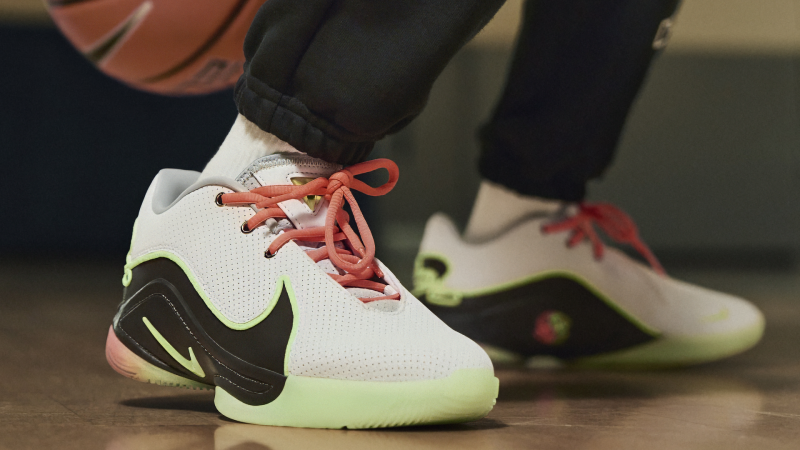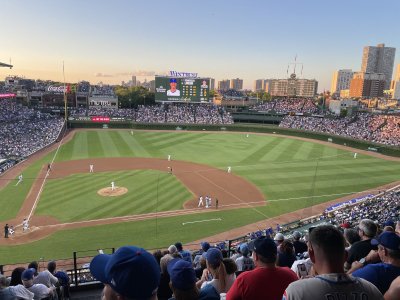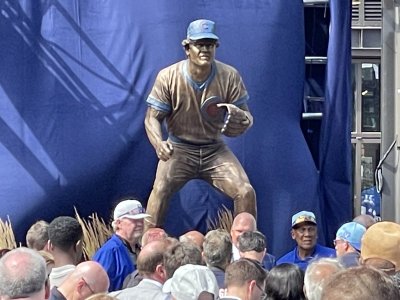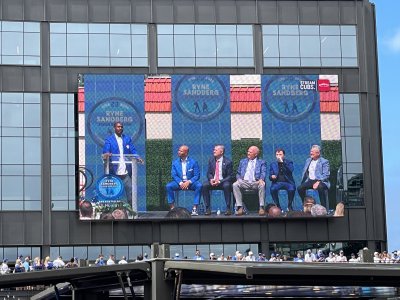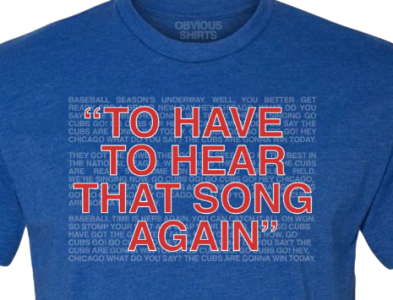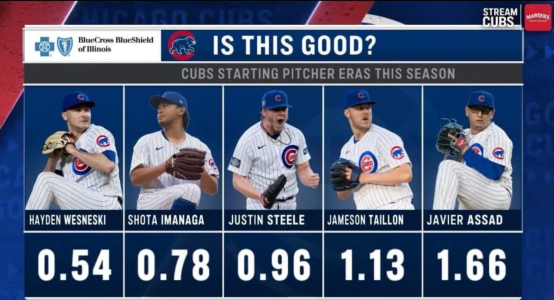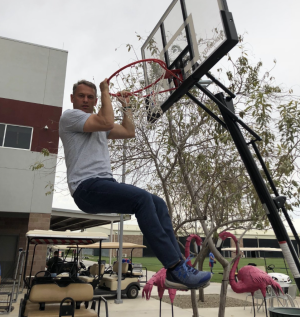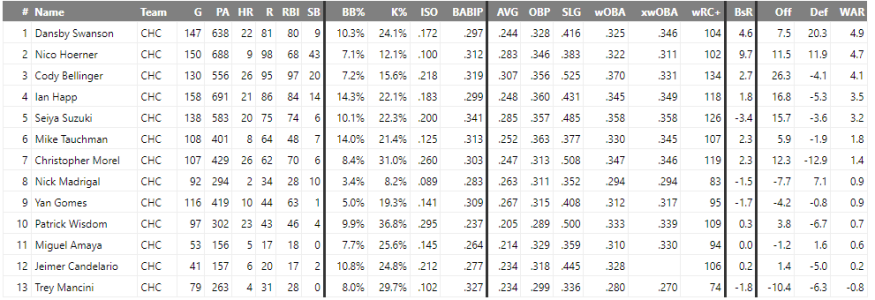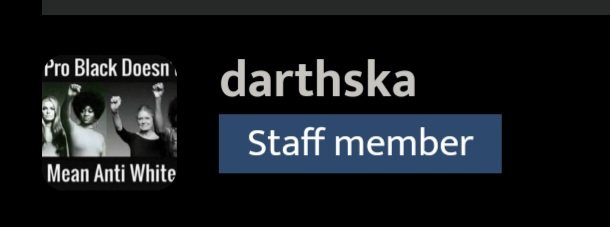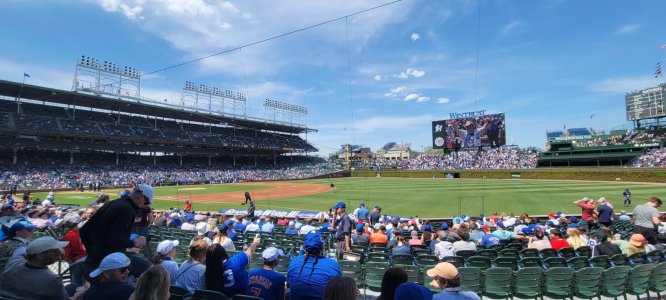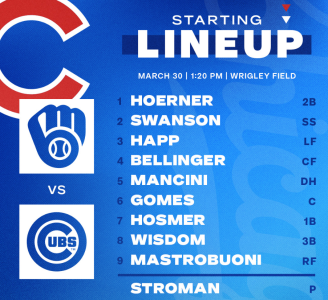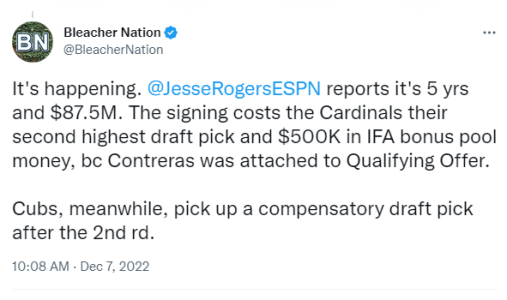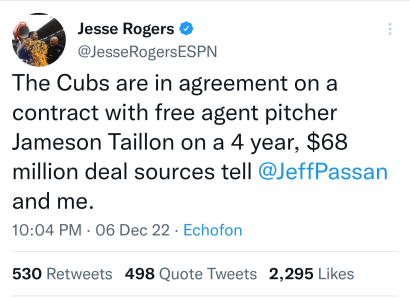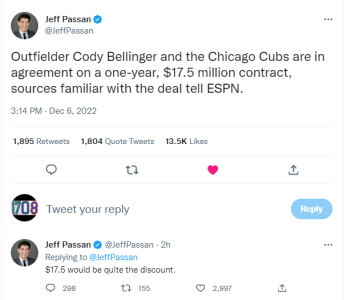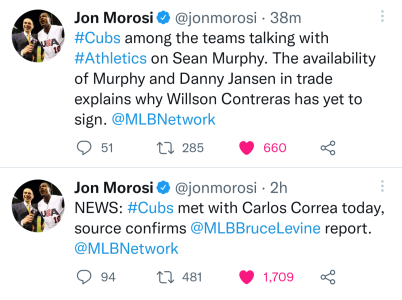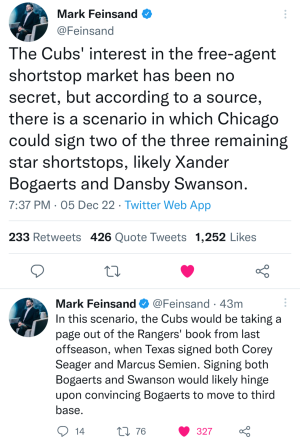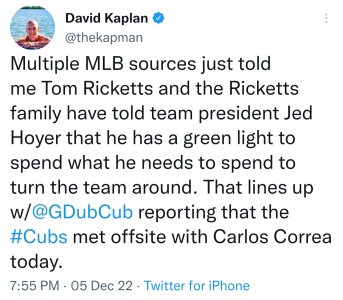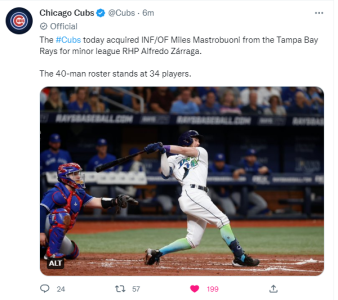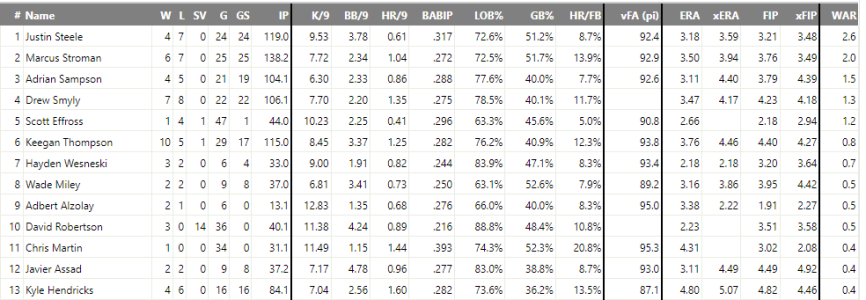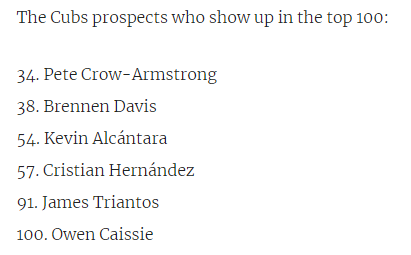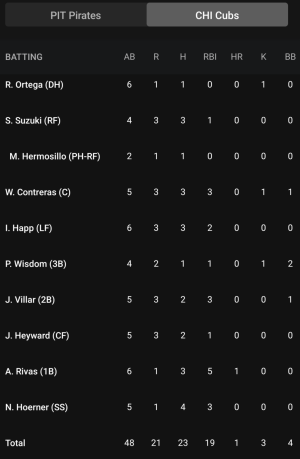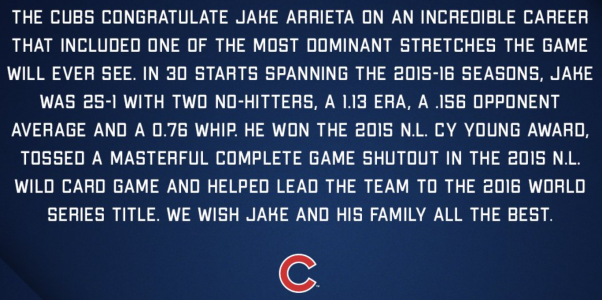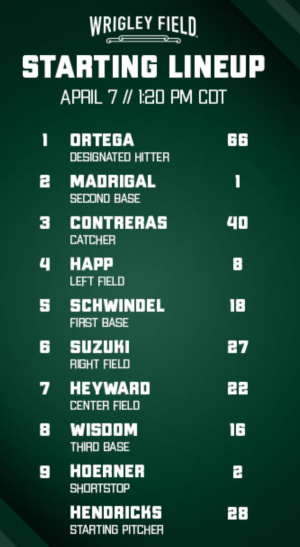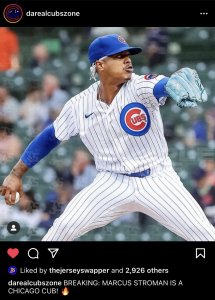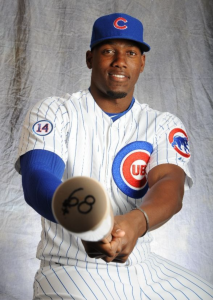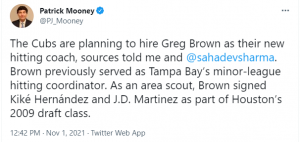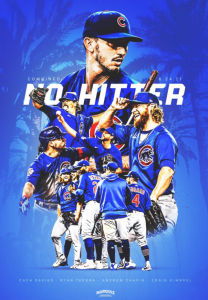Navigation
Install the app
How to install the app on iOS
Follow along with the video below to see how to install our site as a web app on your home screen.
Note: This feature may not be available in some browsers.
More options
You are using an out of date browser. It may not display this or other websites correctly.
You should upgrade or use an alternative browser.
You should upgrade or use an alternative browser.
Official 2023 Chicago Cubs Season Thread Vol: (17-17)
- Thread in 'Sports & Training' Thread starter Started by CP1708,
- Start date
- Sep 7, 2011
- 1,915
- 531
Beat the Cardinals ***, then take Lackey and Heyward, for less money.

arstyle27
Supporter
- Nov 13, 2001
- 10,631
- 3,614
Beat the Cardinals ***, then take Lackey and Heyward, for less money.

Tonight I dine on redbird soup....
Out:
Starlin Castro
Dexter Fowler
In:
Jason Heyward
Ben Zobrist
John Lackey
Adam Warren
The Cubs lose their first two Draft picks, but will gain one back for Fowler when he signs elsewhere. So the Cubs will technically only lose one actual draft pick, which is completely fine considering.
Heyward gets 8/184 and can opt out after year 3. He takes less money to play for the Cubs, than the 200+ million the Cardinals offered him.

Theo has made all this happen, without trading away a single prospect. Meaning we still have a top 3-4 Minor League System, on top of a team that could approach 100 wins.

We have the ability to deal Soler for a pitcher, or maybe Baez, or a combo thereof. We also have the farm system to buy at the deadline if a need arises.
We have MULTIPLE versatile arms that can start or pitch out of the pen. Wood, Warren, Cahill, Richard included. So if Hammel or Hendricks misstep at any point, we have guys that can fill in the gaps and not affect Arrieta/Lester/Lackey. We may even be able to rest these guys here and there thru the season. (And if we do trade Soler for a mid 20’s pitcher, imagine that staff. )
)
Zobrist 2B – S
Heyward CF – L
Bryant 3B – R
Rizzo 1B – L
Soler RF – R
Schwarber LF – L
Russell SS – R
Montero C – L
Pitcher
With Baez/Coghlan our main bats off the bench, from each side of the plate, and guys that can fill in at LF, RF, 3B, SS, 2B in a pinch.
And Theo/Joe Maddon callin the shots.
Starlin Castro
Dexter Fowler
In:
Jason Heyward
Ben Zobrist
John Lackey
Adam Warren
The Cubs lose their first two Draft picks, but will gain one back for Fowler when he signs elsewhere. So the Cubs will technically only lose one actual draft pick, which is completely fine considering.
Heyward gets 8/184 and can opt out after year 3. He takes less money to play for the Cubs, than the 200+ million the Cardinals offered him.


Theo has made all this happen, without trading away a single prospect. Meaning we still have a top 3-4 Minor League System, on top of a team that could approach 100 wins.


We have the ability to deal Soler for a pitcher, or maybe Baez, or a combo thereof. We also have the farm system to buy at the deadline if a need arises.
We have MULTIPLE versatile arms that can start or pitch out of the pen. Wood, Warren, Cahill, Richard included. So if Hammel or Hendricks misstep at any point, we have guys that can fill in the gaps and not affect Arrieta/Lester/Lackey. We may even be able to rest these guys here and there thru the season. (And if we do trade Soler for a mid 20’s pitcher, imagine that staff.
 )
) Zobrist 2B – S
Heyward CF – L
Bryant 3B – R
Rizzo 1B – L
Soler RF – R
Schwarber LF – L
Russell SS – R
Montero C – L
Pitcher
With Baez/Coghlan our main bats off the bench, from each side of the plate, and guys that can fill in at LF, RF, 3B, SS, 2B in a pinch.
And Theo/Joe Maddon callin the shots.

Addison Russell [emoji]10004[/emoji] @Addison_Russell
Even though I might have to change my number I'm perfectly okay with that. I just wanna help fly that #W #goodguys
The Chicago Cubs shortstop wears No. 22. So does new teammate Jason Heyward. Not that you need more reasons to like the Cubs after they agreed to a reported eight-year deal with the free-agent outfielder, but Russell's immediate deference to the veteran -- come on, at least negotiate a new Rolex for that number! -- shows a team with talent and chemistry and, yes, good karma. The last time the Cubs had all that working for them: 1908.
This move is the capper to the rebuilding job by team president Theo Epstein and general manager Jed Hoyer over the past several years, from making brilliant trades to acquire Anthony Rizzo and Addison Russell, to tanking to get high draft picks, to making the right picks in guys like Kris Bryant and Kyle Schwarber, to having the money to spend on free agents like Jon Lester and now Heyward, in part because they've built a young and inexpensive core. This is the blueprint that other losing teams are attempting to follow.
Good luck with that because it's not all front-office brilliance: There obviously have been fortuitous events along the way. Who would have expected Jake Arrieta to emerge into a Cy Young Award winner? To draft Bryant, the Cubs needed the Houston Astros to pass on him and instead select Mark Appel. Manager Joe Maddon became available to hire only because Andrew Friedman left the Tampa Bay Rays for the Los Angeles Dodgers, activating an out clause in his contract.
But here we are: All that did happen. The Cubs arrived a year earlier than expected in 2015, winning 97 games and advancing to the NLCS. They'll head into 2016 as the World Series favorite -- no matter what happens the rest of the offseason -- after signing Heyward, Ben Zobrist and John Lackey to that strong core. Players want to play for Maddon; that makes the free-agent recruiting process a little easier.
For now, Heyward slots in center field. How's this for a lineup?
CF Jason Heyward
2B Ben Zobrist
3B Kris Bryant
1B Anthony Rizzo
LF Kyle Schwarber
RF Jorge Soler
C Miguel Montero
SS Addison Russell
Bench -- Chris Coghlan, Javier Baez, David Ross, Tommy La Stella.
Heyward has been maligned for his lack of power, but I think he's grown comfortable in understanding what kind of hitter he is: Get on base, pop a few home runs, run the bases. He's entering his age-26 season, so the Cubs get his prime years. There's a small chance he improves at the plate, but I wouldn't bet on that. Still, he projects as valuable as a player over the life of the contract due to his defense and on-base ability. That's a lineup with on-base skills at the top, power in the middle and depth all the way through. The bench is versatile and along with Zobrist's flexibility, Maddon has a lot of toys with which to play.
The rotation lines up as Arrieta, Lester, Lackey, Kyle Hendricks and Jason Hammel, with Adam Warren and Travis Wood as long relievers. The rest of the bullpen is solid with closer Hector Rondon, plus Pedro Strop, Justin Grimm and Trevor Cahill.
You can look foolish projecting a team to win 100 games, but this looks like a 100-win team, even accounting for regression from Arrieta. Bryant and Russell should be even better in 2016; the defense will be better with a full season from Russell at shortstop and Heyward in the outfield. The rotation and bullpen are both a little deeper. The Cincinnati Reds and Milwaukee Brewers are expected to be awful, pushing the Cubs even closer to that 100-win mark.
The Cubs might not be done. Much of Heyward's value over the years has been his defense in right field. While he certainly can handle center field -- he has started 30 games there in his career -- he's probably not going to save 20 to 30 runs like he does in right. Considering Soler and Schwarber are both below-average defenders, the Cubs may want to keep Heyward in right and find another center fielder. How about Soler to the Atlanta Braves for Ender Inciarte, the superb fly chaser the Braves just acquired in the Shelby Miller trade?
You don't win anything in December; hey, I just wrote about that. But this has already been an offseason to remember for the Cubs.
viva el birdos @vivaelbirdos
We're not really talking about draft picks, are we? Heyward is one of the best players in baseball. This is a monumental loss.
Then there's the other side of things. The St. Louis Cardinals, who have kicked the Cubs around for decades, lost out on Heyward and Lackey to them, after losing out on the David Price bidding war as well. There was a lot of bitterness on the ol' Internet from Cardinals fans after the Heyward signing was announced. The Cardinals signed a $1 billion, 15-year local TV deal in August that kicks in for the 2018 season, a huge increase over their current deal that pays an estimated $30 million per season.
Their big move so far this offseason has been tendering a contract to Brandon Moss rather than letting him walk.
But there are plenty of players out there for the Cardinals to spend their money on: Outfielders Alex Gordon and Justin Upton make sense, especially with Matt Holliday in the final year of his contract; first baseman Chris Davis would be the power bat they need, if expensive and somewhat risky considering his poor 2014 season; and Johnny Cueto has some bad blood with the Cardinals, but he's the best remaining starter on the market.
The Cardinals didn't get Heyward, but they'll get somebody.
So cheer up, Cardinals fans, the offseason isn't over yet.
CHICAGO -- All the details are yet to emerge, but whether Jason Heyward is a Chicago Cub for three years or for eight, the team got its man.
Heyward, an all-around player who brings a skill set the Cubs were lacking, agreed to an eight-year, $184 million contract on Friday with opt-outs, according to sources familiar with the situation, one coming after three years. The team has yet to make the signing official.
With the addition of Heyward, along with their other moves, the front office has completely transformed the offense -- and team -- over the last 12 months, putting the Cubs squarely in World Series contention. They already were contenders before signing Ben Zobrist, John Lackey and Heyward this offseason, but now they’re more complete than ever. No longer do the Cubs have to hope for a warm summer or for the wind to being blowing out; they now can win games in many ways, both on the mound and at the plate.
At the end of this past season, Theo Epstein identified three areas of improvement for 2016: situational hitting, outfield defense and stopping the run game of the opponent. You can check off two of three so far, as Zobrist and Heyward are quintessential contact hitters while the latter is one of the best right fielders in the game.
For the moment, it looks like the Cubs were not able to complete a second trade-and-sign as they did with Starlin Castro and Zobrist. In that case, it needed to happen as Zobrist wanted to play second base and Castro had to be moved in order for the signing to occur. But with center field open, the Cubs weren’t forced into a trade, so they may go to spring training with Jorge Soler still in right and Heyward in center. It doesn’t improve their outfield defense as much as it would with Heyward in right, but it’s still a situation that can work. The Cubs now have a new second baseman, shortstop and center fielder since opening day 2015. Run prevention up the middle has not been an afterthought.
Now their offense is nearly complete. After bringing home runners from third base with less than two outs at a league-low rate of about 41 percent, the Cubs picked up two players who are both above 50 percent for their careers. In 2014, Heyward brought home an incredible 20 of 27 (74 percent) players in those situations. Last year he dropped to 54 percent, still higher than every Cub regular, save Anthony Rizzo. Contact, on-base ability and power. The Cubs have it up and down their lineup now.
The front office
Anyone who has been paying attention knows Epstein and general manager Jed Hoyer forecasted nearly everything that’s happened to the Cubs since they took over. They didn’t hide their rebuilding plans, instead taking advantage of them. They may or may not admit it publicly, but the best thing to happen to them back then was not having any money to spend. It freed them up to tear the team down and build it back up quickly.
They said they would bring in young talent and rebuild the farm system through trades and the draft and then they would spend money. Some didn’t believe the last notion, because they’ve been burned so many times, but there was Joe Maddon signed to a big deal, then Jon Lester, then Jason Hammel. Then a trade for Miguel Montero added payroll, and then more came this offseason with Zobrist, Lackey and now Heyward. The Cubs even bit the bullet and are paying Edwin Jackson for another year to stay away. Epstein promised transparency and he delivered. And now for the second offseason in a row, he and ownership delivered one of the top free agents available.
The move for Heyward has almost an old-school feel to it. They paid big money to a player who doesn’t hit home runs. That doesn’t happen often, but when that player fits the exact needs of the team -- and is only 26 -- there’s no reason not to go for it. If he leaves after three years so be it. The window with this current pitching staff is about that long, save Lester who’s here for five more years. Soon enough, the Cubs' young position players will be hitting arbitration and the payroll will skyrocket. The more flexibility they have, the better they will be. The opt-out clauses were brilliant -- for the player and the team.
The downside to the deal comes if Heyward isn’t very good and the Cubs are stuck with him for eight years. The deal is back-loaded, according to a source familiar with it, so the Cubs should reap the benefits of it early, but if he’s not very good later in the contract he’ll be eating up a bigger part of their payroll. That’s also when the Cubs should have more money through television deals. The positives far outweigh the negatives. This is a good player who helps make the Cubs a great team.
The National League is there for the taking, and one year after knocking on the door the Cubs have burst through it with a second consecutive successful offseason. Winning the winter doesn’t mean winning the World Series, but in this case the Cubs might win both.
Jesse Rogers wrote that article above today, he also wrote THIS article, last year (exactly 13 months ago).........
CHICAGO -- They might have to wait a year to grab him, but Atlanta Braves right fielder Jason Heyward would be a perfect fit for the Chicago Cubs as they move into their contending phase. Besides being a very good player, Heyward fits the profile of what the Cubs want in signing or trading for key players: He's young.
"The game is going younger," general manager Jed Hoyer said Tuesday at the GM meetings in Arizona. "We're probably going to be too young next year, but the game is moving younger."
Heyward, 25, is set to become a free agent after next season not long after turning 26. That's unique because of his breaking into the big leagues at age 20. How good is he? After Mike Trout, he has the highest WAR (24.5) among players 25 and younger.
Some of that is due to the early start to his career, of course, but his 162-game average over his five years in the league includes 20 home runs and 15 steals to go along with a .351 on-base percentage. He's never come close to the 91 walks he earned in his rookie year in 2010, but his career on-base percentage as a leadoff man is a nifty .357. And he still drew 67 free passes in 2014. The Cubs could use some of that.
"Any team would take Heyward," an agent said Tuesday. "He's going to get a lot of money."
Money is something the Cubs will have come next offseason, when the free-agent class is deeper and Heyward should be available. Could the Cubs pull off a deal with the Braves now and then sign him to an extension before he gets to the market? It's not likely, though they have the prospects to do a trade. It might not cost Kris Bryant or Jorge Soler, but Addison Russell would probably have to go, along with another good prospect, again, presuming Heyward would sign a deal right away.
Atlanta has some decisions to make regarding its entire outfield, as B.J. Upton is signed to a long-term deal, though he has underachieved, and Justin Upton will be a free agent after next season as well.
Heyward is likely to test the market, so a move for him now wouldn't make sense unless he was convinced otherwise.
"He wants the ability to explore it," Braves president of baseball operations John Hart said Tuesday. "This is a homegrown player that we love. There's a lot to like about him. My assumption is it's the wrong time [for a deal]. I don't think there are a lot of legs for doing something on either side. That doesn't mean there can't be a deal a year down the road."
That's when the Cubs should step in with a huge offer. They'll have a better idea how their outfield will look, and if Bryant is the incumbent at third base by then, Soler could move to left field. The lefty Heyward, a top-notch defensive outfielder and two-time Gold Glove winner, and the righty Soler, would make a dynamic duo in the corner outfield positions.
The Cubs say they want to add impact players over the next two offseasons. Heyward would be a good fit at the right age -- either now or later.
From 2010 through 2014, the Chicago Cubs finished fifth.
Fifth in the National League Central, that is. Every year, fifth. Over those same five years the Cubs lost 464 games. And nobody else in the National League, not even the Rockies or the Marlins, lost more than 450. Just two or three years ago, a diehard Cubs fan told me the franchise was in danger of losing its audience, maybe for good.
Well, now it's hard to imagine a well-adjusted Cubs fan with anything to complain about. Actually, that's been a difficult thing to imagine since ... oh, maybe since last April 17, when Kris Bryant finally got into the lineup. Or maybe it wasn't until Aug. 15, when the Cubs won their 15th game in 16 tries, giving them a semi-comfortable lead over the Giants in the wild-card standings.
Of course they would only extend that lead, and actually finished just three games out of first place. Then came the Wild Card Game shutout against the Pirates, and the dismissal of the first-place Cardinals in the Division Series.
By then, only a truly poorly adjusted Cubs fan would have been complaining. But then came the Mets' sweep in the NLCS, and someone might have detected a weakness in those four games. Or pointed out that the Cubs' run differential during the regular season wasn't nearly as good as their record. Or worried about a relatively unproductive outfield, especially with Dexter Fowler testing free-agent waters. Or wondered, more recently, who would play second base, what with Javier Baez struggling in the majors and Starlin Castro getting traded to the Yankees.
And then with just a few swipes of the pen, you gotta be out of your mind to worry over-much about the Chicago Cubs, as the latest projections show them as the best team in the major leagues.
About that run differential last season? Run differential tells only some of the story, and Baseball Prospectus's third-order wins actually showed the Cubs as the second-best team in the National League and the best in their division.
AFTER that, they've now replaced Dan Haren, Travis Wood, and Tsuyoshi Wada in the rotation with John Lackey.
AFTER that, they've replaced Starlin Castro at second base with Ben Zobrist.
And AFTER that, they've replaced Dexter Fowler in center field with Jason Heyward.
All three of these moves are net positives.
The money? It's $32 million for two years of Lackey, and $56 million for four years of Zobrist, and however many millions (with two player opt-outs) for however many years of Heyward. (Our Ken Rosenthal reports it's eight years and $184 million.)
It's a lot of money and the Cubs can afford it, thanks in part to their discipline -- Edwin Jackson notwithstanding -- through those lean years when they were the worst team in the league.
Was it worth it? Well, I suppose you should ask some Cubs fans. Generally speaking, though, rebuilding's probably worth it unless a) it doesn't actually work, or b) you die before it works. There are some long-suffering Cubs fans who literally aren't still around for these salad days. But when you're running a baseball team, you basically have to assume that everyone (except the owner) will live forever. Or at least long enough to enjoy the fruits of your work, however long they take to ripen.
Theo Epstein's fruits have ripened. It's foolish to assume that the Cubs will win a World Series anytime soon, for the simple reason that baseball doesn't work that way. Just one year ago, these Cubs were those Nationals, and those Nationals were 2015's most disappointing team. Even with the best player in the majors. But with five young stars in the lineup and a five-headed rotation monster, betting against the Cubs in 2016 is a great way to throw away your money.
Archie: Higher ceiling Gleyber Torres or Ozhaino Albies?
Klaw: Torres. Better fielder and I think more chance to hit for power. Albies is the safer bet to hit.

The Chicago Cubs’ next move clearly should be bringing in the folks from Jewelers Row in the Loop, and getting their fingers sized for their 2016 World Series championship rings.
Hey, why waste time, right?
Now that the Cubs landed Gold Glove right fielder Jason Heyward to a franchise-record eight-year, $184 million contract, just three days after signing second baseman Ben Zobrist to a four-year, $56 million contract, and a week after signing starter John Lackey to a two-year, $32 million contract, might as well save a few bucks and get the early-bird special on those rings.
The Cubs will be the most overwhelming pick by the media and fans to win the World Series since, uh, the 2015 Washington Nationals.
Yes, and we know what happened to those guys.
Still, there’s a different sense about this Cubs team.
They won 97 games last year. They knocked off their hated rivals, the St. Louis Cardinals, in the playoffs. And now, after spending $272 million in the biggest free-agent outlay by any National League team, they managed to pull off a double-whammy.
They stole away Heyward and Lackey, who spent all season with the Cardinals, and were badly wanted back. The two were the Cardinals’ top two players in Wins Above Replacement, according to Baseball-Reference.
"This is the way it used to be in Boston," Cubs president Theo Epstein told USA TODAY Sports this week." It’s starting to feel that way now, too with us now that we're getting more active in the free-agent and offseason hunts. You try not go get too wrapped up in the Cardinals-Cubs thing, but you always hear from agents, 'Well, if you don’t step up, he’s going to the Cardinals.' "
The Cubs made sure of that, with the second punch to the Cardinals’ gut after losing out on David Price to the Boston Red Sox.
The Cardinals’ fanbase was furious, particularly after it was known he rejected a $200 million deal over 10 years from St. Louis and the Washington Nationals. One fan burned a Heyward jersey and posted the video to Twitter. Another was shown flushing his jersey down the toilet. As you’ve guessed, they’re sure not taking this well.
Cardinals GM John Mozeliak, one of the best in the business, refuses to panic. They’ve reached the postseason the last four years, coming away with a World Series title and two pennants. And they did win 100 games.
Their first point of attack is coming back with another outfielder, and they’ve got their sights set on Alex Gordon, like Heyward a deluxe defensive corner outfielder. And he can be acquired at half the price with a five-year deal for about $75 to $80 million.
And if they can’t get Gordon, they’ll grab power-hitting right fielder Justin Upton or outfielder Yoenis Cespedes.
There are plenty of options, and although the premier pitching market has evaporated, Mike Leake, Wei-Yin Chin and Yovani Gallardo has drawn their attention. Johnny Cueto is the best starter left on the market, but the fan base may not be able to stomach Cueto after the infamous Reds-Cardinals 2010 brawl when Cardinals catcher Jason LaRue suffered a career-ending concussion as a result of a Cueto kick.
The Cardinals may be nervous about their neighbors up north right about now, but certainly they won’t be about to panic.
But check back in September if they happen to be trailing the Cubs by 10 games in the standings.
The Cubs will be good, awfully good, particularly considering the signing of Heyward gives them more flexibility. Now, they can pick up another starter by trading away power-hitting right fielder Jorge Soler for a prized young pitcher, slide Heyward to right, and grab a cheap center fielder. If not, they’ll simply keep Heyward in center field, where he has played only 30 games.
Still, before we crown the Cubs as the next ’27 Yankees, let’s not forget that the Cubs didn’t land Mike Trout or Bryce Harper.
This is Heyward, who hit just 13 home runs and drove in 60 runs last year. He’s the first outfielder in baseball history to receive a contract exceeding $100 million who never drove in or scored 100 runs, according to Sports Illustrated’s Tom Verducci. Sure, he’s a great defensive player, but as far as an imposing threat in the lineup, he may only be the sixth-most dangerous hitter in the lineup.
He plays the game hard. He plays the game right. He’s a solid teammate. And he’s only 26.
Still, if the Cardinals were that enamored about Heyward, he would have been their first priority. Instead, it was Price. And for good reason. Price would have made the Cardinals the prohibitive favorite, no matter what happened to Heyward.
You look at Heyward's numbers, and as Verducci pointed out, his best comp is new New York Mets second basemen Neil Walker. He’s hit only four home runs more than Walker, driven in less than 66 runs, and had the identical 114 OPS-plus in their last six seasons.
If you look over the past season, his numbers are even eclipsed by the center fielder on the other side of town, Adam Eaton. Eaton scored more 19 more runs, hit one more homer, had a higher on-base percentage, and his .792 OPS was just slightly lower than Heyward’s .797.
Sure, Heyward is a welcome addition to the Cubs, and should certainly help cover the ground that left fielder Kyle Schwarber and Soler can’t get to with their limited range. And maybe we should start making our Chicago hotel reservations for the World Series, and stay a few days longer to watch their first championship parade since 1908.
Still, it’s time for everyone to calm themselves a little bit.
Not only in Chicago. But St. Louis, too.
Position: Right Field
2015 Stats: 610 PA, .293/.359/.439, .294 TAv, 9.2% BB%, 14.8% K%, 5.9 WARP
How He Fits: There are times when expectations can cloud our reality. You compare a player to Hank Aaron and instantly visions of a middle-of-the-order bat sending 40-plus balls into the seats each season come to mind. However, through six seasons, that hasn’t been what we’ve gotten with Jason Heyward—who garnered Aaron comps before he even took a big-league hack. Some have been down on the talented right fielder over the years, likely due to the fact that Heyward didn’t fit the mold many had set for him after high rankings and an offhand comment by Bobby Cox suggesting that the ball made the same sound coming off Heyward’s bat as it did with Aaron.
Sure, power is what draws attention to a player, gets the headlines, and one of the primary skillsets one seeks when listing off the top offensive performers in the game. If you run down the top 30 players in 2015 according to WARP, only two players had an ISO below .150: Francisco Cervelli, a catcher who gets on base a ton and frames the hell out of the ball, and Heyward. But before we dive into Heyward’s lack of power—and whether it’s something that could change going forward—let’s take a look at why he did check in as the 12th-best position player according to WARP last season and why he’s a near-perfect fit for the Cubs.
Outside of the obvious need to upgrade the team’s pitching, Theo Epstein has clearly stated the need to improve the Cub’s contact hitting and outfield defense; adding Heyward would signify an immediate step up in both areas for the Cubs. After posting a career-high 27 home runs in 2012, to go alongside a career-low 75.4 percent contact rate, both numbers have been trending in the opposite direction ever since. Last season Heyward delivered a career-best 84.2 percent contact rate (with just 13 home runs, his third straight year below 15), a number that would have led all Cubs with at least 100 plate appearances in 2015. Heyward walks a lot, strikes out rarely, and to top it all off, he’s consistently putting the ball in play. The latter two skills go hand in hand, and they’re something the Cubs are in desperate need of and would happily add to their lineup.
And of course there’s Heyward’s glove. As much as I (and others) have defended Kyle Schwarber’s defense, the fact is, he’s still below average. Below average may have been a compliment for Jorge Soler at times last summer, and center field is currently manned by the patch of grass most recently treaded by Dexter Fowler. Adding Heyward’s defense to the outfield mix would be a huge boost to the club, as that’s where his value is primarily earned. If you’re a fan of the advanced defensive stats, then you love Heyward. Last season, manning right field for 1,217 1/3 of the 1,268 1/3 defensive innings he played, Heyward was second in baseball in UZR (20.2), fourth in DRS (22), and seventh in FRAA (1.
Oh, but you’re suspicious of defensive statistics? Good deal, so am I. How about the eye test?
He certainly passes that. He also won the Gold Glove in the NL and Fielding Bible Award as the best defensive right fielder in all of baseball. But yeah, I get you, the eye test is suspect and awards shouldn’t sway our opinions too heavily either.
Not that I doubted it, but the clincher for me is what every scout I spoke with had to say about his defense: it was roundly agreed that he’s the best glove in right field by quite a bit, with multiple putting an 80 on his defense when he’s in a corner and still above average if moved to center. There was no hesitation from any scout. Heyward’s glove is legit; all the highlights and advanced stats aren’t deceiving us, this kid has proven time and again that he’s the real deal.
Add in that each one of these scouts went out of their way to praise his makeup—as one scout said, “(He) never takes a play off and he just gives a damn.” and that he’ll play 2016 at just 26 years old, and he sure seems like an ideal fit for the Cubs. Imagine a plus-plus defender in right field (or plus in center), who leads by example, works to improve every aspect of his game at all times, puts up a strong .294 TAv, and hasn’t even reached his prime. That’s Heyward and it’s hard to see how he isn’t a perfect target for any team, let alone the Cubs.
Why it Won’t Work: Well, like I just said, Heyward is a fit for any team and has yet to hit his prime. There aren’t too many top-tier players who make it to the open market at the age of 26 anymore, so expect the price for the Georgia native to get to an uncomfortable level. The Cubs’ immediate financial flexibility is really the only thing keeping them from being a complete power house both on and off the field. And while that could—and most certainly should—change down the road, the reality is, the Cubs have to think long and hard when handing out contracts that pass the $20 million mark annually. And there is no doubt, Heyward’s contract will soar past that number.
There’s also the question of where he’d play. Currently, the Cubs have Soler manning right field, and while Heyward would be an upgrade in the immediate future, some would argue that Soler’s offense has significantly more upside. But, well, Soler’s offensive projections aren’t too off from what many saw for Heyward six years ago, so we can’t rely on what may be. However, that’s another argument for another day; the reality is that Heyward fits in the Cubs outfield in two ways: either Soler is traded—most likely for an impact arm—or Heyward plays center field, where many scouts are adamant he’d be above average for at least the next couple years. It may not be a prime setup when you’d have him flanked by two below-average defensive corner outfielders, but it’s an option. And the versatility Heyward provides shouldn’t be overlooked; Soler is stuck as a below-average fielder in a corner, while Heyward can deliver plus defense anywhere in the outfield.
The ideal scenario including Heyward has him as a huge defensive upgrade in right—along with a strong bat at that spot—Soler traded for an arm, and either a one-year stopgap or a glove-first option filling center. There’s a lot of moving parts here, but it’s an undertaking that could help lead the Cubs from an overachieving 97-win team, to one that has legit 97-plus win talent on the roster. And not just for 2016, but for a window that extends into the next decade.
But there are still those low power numbers that just stare us mockingly whenever we look at Heyward’s stats. Yes, one naturally expects more pop from a corner outfield bat, there’s no doubt about it. Interestingly enough, there’s one optimistic school of thought that suggests Heyward, being just 26, will learn to leverage the ball better with his swing and the home runs and ISO will jump in the coming years. But as with his defense and makeup, scouts were generally in agreement that more power is unlikely to come. Sure, they left open the chance, but there was a consensus that his swing just isn’t built to drive the ball over the fence.
“His bat path is a little steep and he can get really closed up with his lower half, which hinders his rotation and ability to really generate leverage and lift his pull side with regularity,” said one scouting director.
“It’s possible to grow, but his swing is complicated and not especially tailored for that trajectory,” added a pro scout I spoke with. “He can hit the (crap) out of the ball, but hitting for power often requires selling out your time in the zone. And for a big man with long arms, Heyward hits more like a leadoff type than a middle-of-the-order bat. He’s very hard into it, so the stroke is shorter with less loft.”
Those were just two of the many sentiments that fell along this line of thinking. Unless Heyward significantly alters his mechanics—which would probably be a poor decision—one should not expect him to be putting up 25-plus homers in a season as he heads into his prime years. Of course, that doesn’t mean he doesn’t have tremendous value at the plate.
While some may obsess over the lack of power from Heyward and assume he’s a bad fit for a corner outfielder, there are a couple things to keep in mind. First of all, the Cubs currently have three bats who are nearly certain to be in next year’s lineup—Schwarber, Anthony Rizzo, and Kris Bryant—who could each hit 25 or more homers. That isn’t even counting Soler and a still-developing Javier Baez. Unlike nearly every other team, the North Siders are well-equipped to handle getting below-average power production from a position that typically relies on pop being a priority.
With that in mind, it’s important to remember just how valuable Heyward is at the plate. A lack of power can completely alter our perception of a player’s offensive value. If I told you that the Cubs were getting Carlos Gonzalez and his 40 home runs, no one would be complaining about the offense. But the reality is, while Heyward doesn’t add the long balls like Gonzalez does, he’s a better offensive threat. Heyward topped Gonzalez in both TAv (.294 to .284) and wRC+ (121 to 114) and is a significantly better baserunner. Heyward just doesn’t put up the type of numbers one expects from a right fielder, thus he gets downgraded. His value on offense is found in his ability to draw walks, to put the ball in play, and to take that extra base—or steal a base, as he has 43 steals in 50 attempts over the last two years.
Yes, it’s a risk to invest significant money in a player whose value derives solely from defense, but it’s not like that’s Heyward’s lone skillset. For other teams, a right fielder who can’t push the 20 mark in home runs would be an issue, but the Cubs aren’t one of those teams. They need elite defense, they need contact, and it never hurts to add another player with pristine makeup who has a solid amount of postseason experience. Oh, and did I mention he’s still just 26? The Cubs may be scared off by his ultimate price tag—though I’d argue that a 26-year-old who is in great shape and possesses the work ethic to remain that way, big contract or not, is exactly the type of player who should get those deals—but what he brings to the table is perfect for this roster. Whether he patrols center or right is something that can be debated going forward, but either way, he’s exactly the type of player this team—or any, really—should be investing significant money in.
Cubs lineup April 2012
David DeJesus RF
Darwin Barney 2B
Starlin Castro SS
Bryan LaHair 1B
Ian Stewart 3B
Steve Clevenger C
Blake DeWitt LF
Joe Mather CF
Pat Maholm P
Cubs lineup April 2016
Ben Zobrist 2B
Jason Heyward CF
Kris Bryant 3B
Anthony Rizzo 1B
Jorge Soler RF
Kyle Schwarber LF
Addison Russell SS
Miguel Montero C
Jake Arrieta P
Javy Baez off the bench.
Theo
David DeJesus RF
Darwin Barney 2B
Starlin Castro SS
Bryan LaHair 1B
Ian Stewart 3B
Steve Clevenger C
Blake DeWitt LF
Joe Mather CF
Pat Maholm P
Cubs lineup April 2016
Ben Zobrist 2B
Jason Heyward CF
Kris Bryant 3B
Anthony Rizzo 1B
Jorge Soler RF
Kyle Schwarber LF
Addison Russell SS
Miguel Montero C
Jake Arrieta P
Javy Baez off the bench.
Theo

Last edited:
- Dec 14, 2001
- 12,426
- 2,239
Jason Heyward deal gives Cubs the top free agent at an extraordinary value
1h
Emailcomment
Keith Law, ESPN Senior Writer
I said in my free-agent writeup of Jason Heyward that I'd be fine giving him seven years and over $150 million, and that's close enough to what the Cubs did here -- I was thinking a $22-23 million average annual value (AAV), and Heyward will indeed get $23 million, but for eight years rather than seven. In a winter market that so far has seen some big escalations in top-end salaries, that's an extraordinary value for the Cubs and all the more impressive because Heyward was the top free agent available.
Heyward is an elite defensive right fielder who can handle center, and he's already proved to be a solid offensive player, showing some power early in his career while more recently becoming a high-contact, above-average OBP hitter who puts the ball on the ground too often. Even as is, he's a 5-6 WAR player, more than enough to justify his salary, and if the Cubs can unlock some of the power that's largely been lost since he shortened his swing due to a shoulder injury, he could become a 7-8 WAR player. The contract values him for what he has been, but the Cubs will get his peak years and reap the surplus if he becomes the complete player he could be.
Heyward can also opt out at 29; while player opt-outs used to be universally terrible deals for clubs, I'm no longer so sure that's the case. As salaries have risen and contracts haven't gotten any shorter, there's a reasonable chance a player who opts out is simply sparing the signing club from paying for decline years. (There's always the chance the player disappoints from day one and doesn't opt out, of course.)
While early indications are that the Cubs plan to play Heyward in center and keep Jorge Soler, still a very high-upside talent despite a disappointing rookie season, I wonder if their long-term plans involve getting Heyward back to right field, where he has been among the most valuable defenders in all of baseball over the past few years. The Cubs don't have an immediate center-field option in the system but could hope that one of Albert Almora or Arismendy Alcantara is ready in 2017 or that Ian Happ adapts to the position well enough to handle it by the end of that season. If nothing else, the contract gives the Cubs a ton of options with their impending outfield surplus, since left fielder Billy McKinney isn't far off and they just spent $3 million on 21-year-old Cuban center fielder Eddy Julio Martinez, who will make his pro debut in the spring.
The Cardinals appear to have been the bridesmaid twice this offseason, first on David Price and now on Heyward, but I don't see cause for alarm in St. Louis, as the returning club is still a 90-win team and the Cards have the payroll and prospects (or young big leaguers) to improve. They do need a starter, and someone like Mike Leake or Scott Kazmir would be a good fit, backing up Adam Wainwright and providing some stability, with both Carlos Martinez and Michael Wacha a bit uncertain for a full workload in 2016. If center field is their concern, without a true center fielder on the roster, they have the assets to trade for one or could see if Denard Span would consider a one-year, get-healthy deal and hope the Cards' coaches can help him the way they helped Heyward. Losing Heyward is more of a loss on defense than offense, and I don't think this offense needs a big bat, not with a full season of Stephen Piscotty in 2016 and Jedd Gyorko added to provide some right-handed pop to boost production at second base.
- Jun 26, 2009
- 9,064
- 1,157
So what position is Schwarber gonna be playing? Is he gonna split time at LF and C? Wonder if Baez will play CF and revert Hayward back to his original position since he's playing CF in winter ball. I know Heyward was signed to be the CF but I feel like I've heard him say he isn't exactly comfortable playing in center.
I wonder if we'll trade Baez/Soler for another SP...personally I'd rather not cause I think the rotation is already adequate.
I wonder if we'll trade Baez/Soler for another SP...personally I'd rather not cause I think the rotation is already adequate.
Last edited:
Lake Shore Drive
formerly slp product
- Feb 8, 2005
- 7,336
- 2,445
- Jan 19, 2002
- 23,516
- 5,671
Any of y'all wanna buy season tickets?
I remember Theo Epstein wandering through the lobby at the 2012 general managers’ meetings in Indian Wells, Calif., looking uncomfortable, muttering something to the effect of, “I’m irrelevant.”
And I remember thinking, and maybe even replying, “Not for long.”
This was coming. We all knew it was coming. The Cubs were far from a quick fix, losing 101, 96 and 89 games in their first three seasons under Epstein as president of baseball operations and Jed Hoyer as GM. But the team reached the National League Championship Series last season, a year ahead of schedule. And now, goodness, Epstein is unleashing the monster.
First, right-hander John Lackey. Then, infielder Ben Zobrist. And on Friday afternoon, outfielder Jason Heyward for eight years, $184 million and two opt-out clauses, after either year three or year four if he exceeds certain plate-appearance thresholds, according to a major-league source.
Epstein and Hoyer also have added lesser pieces: right-handed swing man Adam Warren and infielder Brendan Ryan in a trade for second baseman Starlin Castro, right-hander Trevor Cahill and lefty reliever Rex Brothers. And the Cubs still figure to trade for another starting pitcher and perhaps find a center fielder who would allow Heyward to remain in right.
All these additions, to a team that won 97 games last season. Stunning. Just stunning.
Players are swayed by the allure of helping the Cubs win their first World Series since 1908 — Heyward, like Zobrist, had better financial offers from other clubs. The Nationals offered Heyward $200 million and the Cardinals also were believed to be at that number, according to major-league sources.
Epstein and Hoyer have something to sell — history, Wrigley, Chicago — and they sell it well. Manager Joe Maddon and left-hander Jon Lester enlisted in the Cubs’ crusade last offseason. And the momentum just keeps building.
Yet, as Epstein would be the first to attest, the winners of the winter are not always the winners of the summer. To further the point, free agency has not always been Epstein’s forte, as evidenced by his ill-fated investments in Carl Crawford and Daisuke Matsuzaka with the Red Sox and Edwin Jackson with the Cubs.
Hey, who knows how this will work out? Maybe Lackey finally will reach his expiration date in his age-37 season. Maybe Zobrist finally will enter his decline phase at 35. And maybe Heyward indeed will be everything his critics assert, a player who is not enough of an offensive threat for the money.
I stood with Epstein and Hoyer at this year’s general managers’ meetings in Boca Raton, Fla., relaying to them the frustration I was hearing from the agents of other free-agent hitters about Heyward being the prized position player in this year’s market.
Epstein sort of scoffed, saying something to the effect of, “it’s not 1970 anymore” — meaning, players today are valued for their defense and base-running more than they were in the past, not that Heyward is a subpar offensive performer.
To hear rival executives tell it, Epstein long had been fixated on Heyward, going back to the right fielder’s early years with the Braves. The attraction, once Heyward reached free agency, was not simply the player’s all-around game.
Do the math — the additions of both Heyward and Lackey were subtractions for the rival Cardinals. Do some more math — Heyward, at 26, is that rare player who hit free agency at the start of his prime.
The first opt-out clause will give Heyward a chance to re-enter the market at 29 — still in his prime. The contract is expected to be front-loaded, with the Cubs gladly paying a premium in the early years. If Heyward performs well and bolts, so be it. The Cubs might win a World Series by then.
Not bad, considering that Epstein and Hoyer are not yet operating at full financial strength; the team cannot secure a new TV deal until after the 2019 season. Management’s plan to load up on young hitters not only gave the Cubs an advantage at a time of diminishing offense, but also created the payroll flexibility for the combined $272 million commitment to Lackey, Zobrist and Heyward.
There is just one problem with it all, and it is not a small problem, considering the way the Cubs are developing into a powerhouse. One of their biggest stars is eligible for free agency at the end of this season, and he will not be inexpensive.
That star is Epstein, who will be in position to receive an even bigger contract than his current five-year, $18.5 million deal.
The Cubs will pay. They will happily pay. They are irrelevant no more.
- Sep 7, 2011
- 1,915
- 531
How many years would you give Theo on his new extension?
- Apr 4, 2008
- 75,071
- 24,467
As many as he wants
- Aug 15, 2009
- 9,404
- 11,762
I'm a White Sox fan born and raised but I have nothing but respect for Theo and this Cubs squad. I see this team finally ending the curse in the next few years 

On Friday, the Cubs won the bidding for Jason Heyward, convincing the outfielder to come to Chicago despite offers for more guaranteed money from the Nationals, the Cardinals, and reportedly one other team, perhaps the Angels. While Chicago’s offer of $184 million over eight years is certainly a substantial amount, he apparently could have taken $200 million guaranteed by going with one of the other offers. Instead he chose the Cubs, and along with putting him on baseball’s best team in 2016, the fascinating structure of the contract Chicago gave him may end up making this deal a big win for both sides.
The case for the contract being a big win for the Cubs is easy; Heyward is a very good player who will be paid like a decent one during his time in Chicago. To this point, Heyward has put up +28 WAR in six years in the majors; for the Cubs to break even on the total guaranteed moeny in this deal, Heyward would have to only put up about +20 WAR over the next eight years. This is essentially the kind of performance the Cubs are paying for with this deal.
Jason Heyward’s Contract Estimate — 8 yr / $181.9 M
Year Age WAR $/WAR Est. Value
2016 26 3.3 $8.0 M $26.4 M
2017 27 3.5 $8.4 M $29.8 M
2018 28 3.3 $8.8 M $29.1 M
2019 29 3.0 $9.3 M $28.2 M
2020 30 2.8 $9.7 M $27.2 M
2021 31 2.0 $10.2 M $20.9 M
2022 32 1.3 $10.7 M $13.9 M
2023 33 0.5 $11.3 M $6.2 M
Totals 19.9 $181.9 M
Assumptions
Value: $8M/WAR with 5.0% inflation
Aging Curve: +0.25 WAR/yr (18-27), -0.25 WAR/yr (28-30),-0.75 WAR/yr (31-37),-1 WAR/yr (> 37)
To get that number out of the contract estimating tool, I had to start Heyward at +3.3 WAR and choose the pessimistic aging curve, and that’s about as dim a view as one could possibly have of his overall value. Even if you eliminated 100% of his defensive value, projecting him as an average defensive right fielder going forward, he’d still project as a +3.5 WAR player, given his offensive production and quality baserunning. Forget regressing defensive value; for him to be worth only $184 million over the next eight years requires the type of analysis that concludes that defense is completely irrelevant beyond the position a player takes on the field.
Of course, that’s not a particularly rational belief, and every piece of available information suggests that Heyward adds a good amount of value in the field. Based on what they’re paying him, the Cubs are basically getting that value for free, and barring an injury, they’re very likely to come out with a significant bargain during the time Heyward is in Chicago. $23 million a year for a player of Heyward’s value is a very nice value, especially for a team in a competitive division, where the value of adding marginal wins is very high.
But, of course, this contract isn’t a straight eight year, $184 million commitment from both sides. That’s the amount the Cubs guaranteed Heyward as a floor, but because his representatives at Excel negotiated two opt-out clauses into the deal, the likely outcome is that he’s going to end up getting a much better deal than that over the long-term. It was long assumed that Heyward would get an opt-out clause in whatever contract he ended up signing — Excel has a history of getting them included for their clients, and Heyward is the kind of player where getting another crack at free agency has the most upside — with most speculation suggesting it would come halfway through the expected nine or ten year deal he would sign.
Instead, Heyward took a slightly shorter contract, and in doing so, moved up his chances to get back on the market. Since the Cubs gave him opt-outs after the 2018 and 2019 seasons, from his perspective, this is really a three year contract with a one year player option, followed by a four year player option after that. Assuming a normal payout structure with a slight increase in salaries over the life of the deal, this deal is probably going to end up paying Heyward something like $65 million over three years or $88 million over four years before he hits the free agent market again.
At that point, Heyward will probably not be as good of a player as he is now, as we shouldn’t expect him to retain all of his early-career defensive value, and he’s approaching the point where we shouldn’t expect the offense to improve dramatically. If he loses roughly half his defensive value over the next three years, he’d be looking at hitting the market again as a 29 year old who projected as about a +3.5 WAR player. The most recent comparison of a left-handed hitting corner outfielder with big platoon splits selling his decline phase was Shin-Soo Choo, and he got $130 million over seven years from the Rangers for his age 31-37 seasons. Heyward will be two years younger than Choo was when he landed his deal, and that point, there will have been five years of inflation in MLB since Choo’s deal was signed.
Choo’s deal is probably something like the floor for Heyward’s next contract — again, assuming he stays healthy, which is the primary variable in whether he’ll opt-out or not — and he’d probably only take that deal after the second option, as he’d probably prefer a one year, $23 million pillow contract by picking up his first option to try and have a better walk-year if his 2018 season wasn’t very good. So if we gave him the 7/$130M that Choo got and add that to the roughly $90 million that he’ll get from the Cubs in the first four years of the deal, that puts him right around 11/$220M.
But Choo’s deal is going to be ancient history by the time Heyward actually reaches free agency, and inflation is going to make it likely that he lands a much larger deal than Choo’s deal in a few years. When Choo signed his deal, teams were paying roughly $6 to $7 million per win; when Heyward is deciding whether to use his first opt-out or not, the market will probably be closer to $9 million per win. Here’s what a +3.5 WAR outfielder, selling his age-29 to age-35 seasons, would expect to get in that kind of market.
Jason Heyward’s Contract Estimate — 7 yr / $171.6 M
Year Age WAR $/WAR Est. Value
2019 29 3.5 $9.0 M $31.5 M
2020 30 3.5 $9.5 M $33.1 M
2021 31 3.0 $9.9 M $29.8 M
2022 32 2.5 $10.4 M $26.0 M
2023 33 2.0 $10.9 M $21.9 M
2024 34 1.5 $11.5 M $17.2 M
2025 35 1.0 $12.1 M $12.1 M
Totals 17.0 $171.6 M
Assumptions
Value: $9M/WAR with 5.0% inflation
Aging Curve: +0.25 WAR/yr (18-27), 0 WAR/yr (28-30),-0.5 WAR/yr (31-37),-0.75 WAR/yr (> 37)
If he collects roughly $70 million before the first opt-out, then sees a market where his fair value is around 7/$170M, it’d probably be a pretty easy call for him to hit the market and reset his salaries. At that point, the contract would end up paying Heyward something like $240 million over ten years, or right in line with the mega-contracts that Albert Pujols and Robinson Cano commanded. And this is assuming Heyward declines from a roughly +5 WAR player now to a +3.5 WAR player over the next three years. A total payday of 10/$240M for Heyward isn’t even the optimistic scenario, as he’d probably be able to get another deal worth $200 million deal if he still projected as a +4 WAR player going into his age-29 season.
These opt-outs are why Heyward took only $184 million. As Eno noted after the David Price signing, the opt-out was probably worth something like $10-$15 million for Price, an older pitcher with a significantly higher chance of collapse. For Heyward, each opt-out is probably worth more, and by doubling up on the chances to hit the free agent market again while he’s still in his prime, he’s put himself in a position to end up with something like $250 million over his remaining productive years.
So, yes, the Cubs got a really good value by signing Heyward for 8/$184M, but given that he’s now got a floor of $184 million with a more likely outcome of something like $240 or $250 million, this deal should work out just fine for Heyward as well. He might have left a little bit of guaranteed money on the table, but getting the 2018 opt-out probably should outweigh the value of getting a few million more per year during the part of the contract that is likely to get voided anyway.
While opt-outs are always going to be player friendly clauses, this contract is a perfect example of how including an opt-out in a deal can make a contract a win for both sides. The Cubs get a really good player at a bargain price for the first three or four years of the deal, and as long as Heyward stays healthy, he’ll get another nice contract in a few years. For both the Cubs and Heyward, this is a win-win contract; the losers in this deal are the rest of the teams in the NL Central, who are going to have to figure out how to contend with a juggernaut for the foreseeable future.
The Chicago Cubs won 97 games last season, went to the National League Championship Series, and had one of the top prospects in baseball debut with outstanding success. Many teams might look at such a season, nod their heads with approval, and try to simply maintain a semblance of that high level of achievement when planning and making moves for the following season. The current version of the Cubs, however, are in win-everything mode, and they seem desperate to improve upon a 97-win season. With an aggressive Theo Epstein, deep-pocketed owners, and a clear window to make a run at a long-absent title, the Cubs have already made some of the biggest acquisitions of the 2015 offseason.
The biggest, of course, is Jason Heyward, a top 15 player by Wins Above Replacement during the 2015 season. With his eight-year, $184 million contract, he joins Anthony Rizzo and Kris Bryant as the young core of a team that could challenge for World Series titles for the foreseeable future. It's easy to proclaim the Cubs as favorites to win one of the strongest divisions in baseball after this move -- they did, in essence, turn one of their rivals' best players into one of their own -- but that idea is cemented by the fact that they now have three of the best 20 position players from last season by WAR. Take a look at the top 20 position players by WAR, with each player's 2016 team:
View media item 1828006
The Cubs head into next season with three out of 20 of this past season's best players, and that's the kind of statement that forces everyone to sit up and take serious notice. Having two position players of this caliber is rare enough for a team in a given year; having three is a foundation on which dynasties are sometimes built.
If we assume that all three players will stay healthy and produce at around the same level next year, each will be in the top 20 or better for position players (per Steamer projections on FanGraphs, Rizzo, Bryant, and Heyward are all projected to be top 10 players, in fact). This got me thinking: what is the track record of teams that have this level of talent in their lineup? Have they accounted for a disproportionate number of World Series victories, even if we don't take into account the strength of their respective pitching staffs?
To answer that question, I've pulled data for every team's position players from 1950 to 2015, narrowing the list down to only teams that had three or more players with greater than 5.0 WAR during a season. For reference, there are usually only 20-25 players with greater than 5.0 WAR in any given year: these are the elite players in the game. In 2015, Bryant produced 6.5 WAR, Heyward 6.0, and Rizzo 5.5.
We're left with 82 teams that had three such players, starting with the 1950 New York Yankees (Phil Rizzuto, Yogi Berra, and Joe DiMaggio) and ending with the 2013 Boston Red Sox (Shane Victorino, Jacoby Ellsbury, and Dustin Pedroia). Out of those 82 teams, 25 (30%) went to the World Series, and 12 won the whole thing. Take a look at an interactive plot of our 82 teams, with marks on who won the Fall Classic -- you can scroll over each point to see each individual team's record, as well as the three 5.0+ WAR players:
What's most striking is the high floor for the win total of teams that fit this criteria: with the exception of two clubs (the 1991 Reds and 1998 Mariners), every single one of the teams in our sample was above a .500 win/loss record during the season in which they had three 5.0+ WAR players. The average win total for these teams was just over 94, telling us how successful most of these clubs were during these seasons. Another impressive angle of this exercise is that it doesn't take into account the strength of each team's respective pitching staffs. Great rotations, bad rotations -- the teams we've highlighted won more often than not, and usually posted win/loss records that at a minimum put them into the playoffs.
Really, all of this makes sense. Put at least three elite position players on the same team, and good things happen. There's a reason we know many of these teams by name: the Cincinnati Reds during the 1970's were The Big Red Machine, and they had three players with greater than 5.0 WAR in 1970, '72, '73, '74, and '75. Great teams usually have one or two great players. Dynasties have many.
What sets this current Cubs team apart from the other teams we've highlighted?
In a word, youth. The three best players that make up Chicago's core are all under 27: Rizzo and Heyward are both 26, and Bryant is 23. Even though Rizzo and Heyward won't turn 27 until early August of 2016 (their birthdays are only one day apart), let's take our exercise one final step further: we'll narrow down our 82 teams one more time, this time filtering out any players who were past their 28th birthday during the season they produced 5.0+ WAR. That will give us only clubs that had a core of three players as young as this upcoming 2016 Cubs team.
How many teams since 1950 have had three position players under 28 years old, each with greater than 5.0 WAR? Only 16. The 2016 Cubs are projected to be another, the first since the 2009 Rays. This is rare territory, in which the combination of youth and incredible talent occurs. Based on the evidence here, expectations for the Cubs are probably right where it should be heading into the 2016 season: they just added one of the top 15 players in baseball to a strong, young core that already included two other players that ranked among baseball's best. Before that happened, they got Ben Zobrist, another player with a proven track record.
How much more can a 97-win team improve itself? We might not think very much, but it's happening in front of our eyes. That's domination of the market, and it's no doubt scary for everyone who has to face them next year. Most of all, though, it's rare: the whisperings of a potential dynasty built on the work of good scouting, and a few cool December nights in Nashville.
I saw a reference not long ago to the White Sox and Padres, regarding how they tell us it doesn’t matter who wins the offseason. The reference was made in an article about the Cubs. Now, the Cubs’ offseason isn’t over. Nor are the rest of the offseasons, so, who knows how the landscape will look by the end? But there are some crucial differences here. For one, there was more criticism of what the White Sox and Padres did. For two, the Cubs have worked on a team that was already legitimately good. As I write this, I believe the Cubs are the best team in baseball. It’s not irrefutable, but there’s a hell of an argument for the opinion.
More moves will be made, and we’ll see improvements to other contenders. The Cubs’ projection is unlikely to budge very much. Still, there are active rumors, surrounding players like Jorge Soler and Javier Baez. Reports suggest the Cubs are most interested in strengthening their starting rotation. Reports aren’t the same as actual moves, and actions speak louder than words and all that, but it’s worth wondering: how badly do the Cubs need a starting pitcher? Consider this part 1 of our series: how badly do the Cubs need anything?
If you think back to the playoffs, which weren’t actually all that long ago, the Cubs’ starters got exposed. Kyle Hendricks ran an ERA over 5, and Jason Hammel wasn’t allowed to throw even 50 pitches in either of two starts. That wouldn’t have been such a big deal had Jon Lester not shown cracks, and had Jake Arrieta not shown cracks, and had the whole lineup not shown cracks. The last time we saw the Cubs, they got steamrolled by the Mets, but you don’t judge a team by four games. The Cubs were good, and the Cubs should be good.
Isolating just the rotation, last year, the Cubs finished first in baseball by WAR. Sure, the group was topheavy, but rotations frequently are. Switching to RA9-WAR, for a different opinion, the Cubs finished third in baseball. The numbers were inarguably terrific. Since then, little of note has been lost, and John Lackey has signed for a couple of years. So here’s how the Cubs’ rotation currently projects for 2016, by Steamer and our own playing-time guesses:
View media item 1829495
The Free Agents are loaded, but thankfully for everyone else, they’ll end up mostly disbanded by April. So right now, the Cubs project worse than the Dodgers, but better than the remaining 28 clubs. Obviously, the remaining 28 clubs will make more moves. Obviously, projections don’t predict the future with 100% accuracy. The point isn’t whether the Cubs are first, or second, or third. It’s that they look really good, rotation-wise. There’s not really any reason to believe this is a weakness.
What the Cubs have managed to assemble is both talent and depth. At the moment, this is the likely five:
Arrieta
Lester
Lackey
Hendricks
Hammel
Yet nearly no team goes through a season with just the five original starting pitchers. The Cubs understand that, and this is much of what they have as rotation support:
Adam Warren
Trevor Cahill
Travis Wood
Clayton Richard
Warren’s the newest, and he’s probably the most interesting. As a starter with the Yankees he ran a sub-4 FIP with four pitches he threw at least a tenth of the time. The others have their own attributes, and it doesn’t matter much if you don’t love Richard, because he’s ninth on the list. No one loves a team’s ninth starter.
The Cubs have the starters and the depth. Lester is under control five or six more seasons. Hendricks has another five. Arrieta and Lackey have another two. Hammel has another one or two. Of the depth guys, Warren’s got three seasons of control. This group isn’t coming apart next winter. The short- and medium-term outlooks are favorable.
So why the reports? They could just be wrong. That possibility can never be dismissed. But let’s give the reports some validity, because the front office has talked about this. On paper, it doesn’t look like the Cubs really have a need. Yet they’re acting as if they might, and this leads us to a nifty principle: if a smart team is trying to do something that doesn’t immediately make perfect sense, assume the smart team has some information. Sometimes this can lead you astray, but you should never assume you’ve considered something that Theo Epstein and Jed Hoyer haven’t.
Could be the Cubs just want more young, cost-controlled starters. They’ve been linked to names like Danny Salazar and Carlos Carrasco, and since they took a bat-first approach to organizational development, maybe they’re just looking for an exchange. Maybe it’s just about being proactive, although the current market for starting pitching could drive a sane team elsewhere. The Shelby Miller deal did nothing good for teams sniffing around effective young arms.
That would be the long-term view, yet teams this good tend to focus more on what’s ahead. The Cubs might have more questions about 2016 than the projections would let on. Take Hammel. His was a 2015 season of two very different halves, the second and worse one coming after a return from a hamstring injury. By the time the playoffs rolled around, Hammel had nobody’s trust, and the Cubs might not love his chances of bouncing back.
However, second-half Hammel still had solid peripherals, and the Cubs know that’s generally encouraging. And Hendricks, in the second half, saw his strikeout rate leap forward. There’s some chatter that Hendricks may yet be exposed, as a finesse arm without an out pitch, but at this point it would be fair to say he’s mostly proven, and these are back-of-the-rotation guys anyway. There’s insurance in case they struggle.
I’m left with a gut feeling that the Cubs might be nervous about Arrieta. He was dominant almost all season long, to a historic extent, but he threw just shy of 250 innings, and in his final start, he lost a mile off his average and top-velocity fastball. Sometimes that’s nothing, and the weather was cold, but it grabs your attention, and it’s not like an injury would’ve come out of nowhere. Arrieta was used heavily, and the last time he pitched in 2015, he looked like it. In 2014, he fell short of 180 innings. In 2013, he fell short of 160. Arrieta’s talent is almost irreplaceable, and if something were to happen to him, the Cubs would be left looking mortal.
It’s hardly worth writing that the Cubs would look worse without Jake Arrieta. Everyone would look worse without their No. 1, and an injury is never guaranteed. Madison Bumgarner, last year, wore his heavy 2014 usage just fine. But the Cubs could look at Arrieta and see a heightened risk. There’s already perhaps been a symptom, and when you have a winning opportunity this good, you’d like to have insurance in case something goes catastrophically wrong. If the Cubs added a cost-controlled, long-term starter, it would be good for the future, but it would also help support the present, a present that might be a little more risky in reality than it seems in the projections. The Cubs of April 2016 already look fantastic. They’re now perhaps thinking about a half-year later.
Off the bat, Epstein admits that, while it has been an active and highly praised offseason, it’s best to ignore the attention. “Typically, teams that get the praise in December have time on their hands come October.” If you remember, the Chicago White Sox and San Diego Padres were widely praised last offseason, for their aggressive moves, and both wound up with disappointing, underwhelming seasons.
At the same time, Epstein continued that it was the right time to be aggressive – which, clearly they were – given the composition of the roster, next year’s weak free agent class and the long term outlook of the team.
On whether there are more moves to come for the Cubs this offseason, Epstein reiterates that they are most likely done, barring smaller moves here or there. He leaves the door open to a bigger move, though, claiming that they are still considering a couple of those types that would push them in one direction or another, but admits that they aren’t too appealing right now. Given how pricey young, cost-controlled starting pitchers have been, it’s not difficult to connect the dots. It doesn’t sound like a big trade for additional pitching is considered probable right now.
As of now, Epstein is happy to start the season with the roster as constructed. He did mention some interesting bits on seeing how players react to new positions (possibly Jason Heyward, or even Javier Baez in center field) and how players improve their defense (possibly Jorge Soler in right field) before any more decision are made. Given Soler’s immense offensive upside, I’m sure most of us would be glad to see him get another full shot at an entire season right field if the defense was looking tolerable.
Given that the Cubs haven’t really dipped into their prospect assets yet in trade, Epstein sees the Cubs positioned well to make some “midseason adjustments” if needed.
While he understands the challenge in valuing a player like Jorge Soler, due to his limited duty over the past few years because of injuries (and the time missed during his defection from Cuba), Epstein’s adoration hasn’t been shaken. “It wasn’t too hard to scout the postseason, last year,” referring to Soler’s fantastic performance in the nine or ten games he played. “He was probably our best hitter during that stretch. I don’t think it was a coincidence, I love this guy’s future.”
Epstein went on to acknowledge that they’ve challenged him to improve his defense and possibly “get leaner and more athletic” over the offseason to help in that effort. He’s seen video on Soler recently, and the young right fielder has already improved on his reads and jumps in right field while getting his weight down to 225. “We’re putting our stock in this guy’s future, barring something completely unforeseen.”
Epstein would not like to find another center fielder (allowing Heyward to play right field), if it meant costing at bats for Soler or Kyle Schwarber. In a perfect world, Epstein would just be adding to the Cubs’ bench. Soler’s right-handed bat goes a long way to assist the Cubs’ potential vulnerability against left-handed pitchers. Epstein is fairly resolved in his commitment to Soler throughout the discussion. Upon hearing all of this, I’ve come to the point where I’d be fairly shocked to see Soler moved, before the season.
There’s always attrition in the bullpen and Epstein doesn’t see Maddon’s bullpen usage as a reason or cause of that attrition. Instead, Epstein indicated that Maddon’s bullpen strategy has altered the type of relievers they target, specifically in reference to guys that could go multiple innings (super utility pitchers).
Continuing on with the idea of super utility pitchers, Epstein indicates that they don’t want (and obviously don’t only have) just one long reliever who goes out exclusively for mop up duty. Instead he wants several guys that can help out effectively over multiple innings. With Trevor Cahill, Clayton Richard, Travis Wood and Adam Warren, the Cubs have that in spades.
We’ve talked about this idea a lot lately, and it’s interesting to note that it might have spawned by way of Joe Maddon, as opposed to a concerted effort by the front office. As we start to see more pitchers relieving starters for multiple innings in the minor leagues – Carl Edwards, Jr., Corey Black, Armando Rivero, etc… – we may be witnessing the beginning of an organizational (or possibly league-wide) change in methodology.

